Water supply from a well - many options, choose according to
The implementation of any of the water supply schemes requires a great deal of experience and professionalism - from choosing a drilling site to laying pipelines in the house. Do not forget, the electronic system of management and control will interfere in the matter, which significantly complicates the schemes and their implementation.
It will also be necessary to provide for all kinds of protective mechanisms in case of emergency situations, and here there is no experience, much less to do.


Requires a professional approach
The general scheme of water supply does not strongly depend on the type of well used - “on sand” (left - A) or “on limestone” (right - B) - and is shown in Figure “A”:
- 1 - mesh filter for the well directly at the bottom of the casing, this does not exempt from the need to install a whole system of specialized filters in the house;
- 2 - submersible pump;
- 3 - clay locking with a blind area - protects both from melt and rain waters, and from water extracted from the well as a result of the first, main, and subsequent, preventive, pumpings;
- 4 - the so-called pipeline-gander, as a distinctive feature of the upper outlet of the “well to the sand”;
- 5 - casing;
- 6 - a caisson chamber, already a feature of a deep “well on limestone”, for pressure equalization;
- 7 - pump, if the well is an artesian high pressure, then the pump can be neglected, but usually, only for the first time of using the well;
- 8 - automatic control system with overload protection relay;
- 9 - hydroaccumulator - an indispensable part of any water supply system from a well.
Ventilation outlet
The “B” picture shows a very similar, but at the same time, more perfect scheme of water supply to an individual house - here a ventilation outlet from a caisson is used..
We note that this scheme uses a fundamentally important water drainage through a pipeline outside the house directly from the caisson:
- A - ventilation of the caisson chamber;
- B - caisson;
- C - sand layer;
- D - safety cable of all equipment lowered into the well, it is impossible to forget about it;
- E - a protective case of the main pipeline to the house;
- F - electric cable for pump control;
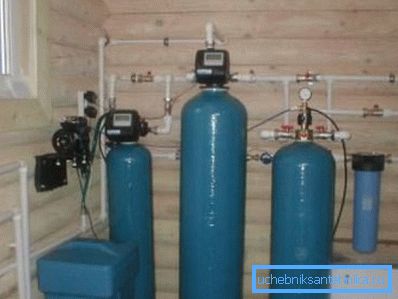
- G - clay layer;
- H - check valve;
- I - pump, we notice the filter in this scheme is pulled up, it is permissible if the well was pumped well initially;
- J is a layer of limestone;
- K - pressure switch is an obligatory protective mechanism that can be connected to the water drainage channel outside the house, in case of an emergency pressure increase;
- L - membrane tank, usually for home conditions, there is enough tank for 60-70 liters;
- M - manometer;
- N - control panel;
- P - normal, standard home power supply in 220 V and 50 Hz.
Circuit diagram
The power supply of the main components of the system is as follows:
- A - boiler or any other electrical device for heating water from a well;
- B - water tank of 40-50 liters, although its capacity is a matter of everyone's preferences;
- C - protection relay against pressure drops in both directions, when the pressure drops sharply or sharply and increases significantly;
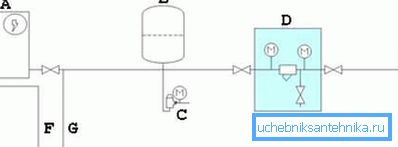
- D - filter - usually several filters are inserted into the system, often of a specialized nature (for iron, for hard water);
- E - part of the circuit directly in the well;
- F - heated water outlet;
- G - cold water outlet.
Realizations - one goal, ways to achieve different
Let us consider several schemes for the implementation of water supply from a well at home, which differ in the use of very useful specific equipment. We advise you to pay attention to these nuances.
Protection against loss of water
Such protection is one of the most urgent tasks of providing water to a country house..
The way to implement it in the following diagram:
- A - well, note, the scheme does not depend on the type of well - perfect - imperfect, on sand - on limestone, from a free-flow layer - from a pressure bed;
- B - submersible pump;
- C - non-return valve - notice the very important wire going to the relay; it provides instant protection in the absence of water, even without analyzing the pressure and the presence of water in the pipes at the top;
- D - ground level;
- E - pipeline;
- F - hydroaccumulator;
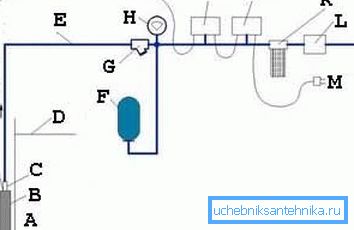
- G - coarse filter, it is also called a mud tank - a very whimsical element of the system, which often have to be removed for maintenance;
- H - manometer;
- I - pressure switch;
- J - dry run relay - this is a distinctive feature of this implementation;
- K - another filter with replaceable cartridges;

- L - pressure reducer;
- M - standard power supply at 220/50;
- N - then consumers in the form of sanitary facilities and washing machines; One of the most notable such consumers is the gas boiler, which can be connected as follows:
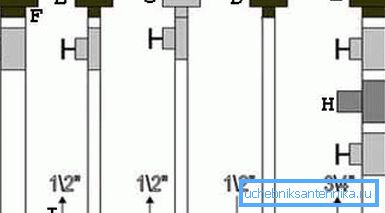
- A - heating supply;
- B - water supply;
- C - gas supply;
- D - reverse water channel;
- E - the return channel of the heating system;
- F - American type nut;
- G - ball valve;
- H is a filter, usually a device for rough cleaning is sufficient;
- I - arrows indicate the direction of the current medium, the numbers - the recommended diameters of pipelines.
Warming and waterproofing
When it comes to working with a well, then in no case should we forget about low temperatures and a high probability of water freezing in the pipes. Hence the need for waterproofing and insulation (in Figure "B" both tasks are solved using a canister - E).
The scheme that puts the problem of warming to the forefront can be:
- A - caisson chamber;
- B - waterproofing;
Helpful advice! When creating a waterproofing we advise you to follow the “golden” rule - it should consist of several layers. For example, on the lower layer there is insulating plaster, then a ventilated layer, then polyethylene on the batten. Be sure to cover the polyethylene in one piece. If this is not possible, then connect the edges of the neighboring sheets with waterproof tape on both sides.
- C - insulation, usually in the form of moisture resistant foam boards;
- D - electrical cable in a protective casing;
- E - seals, the system must be extremely tight;
- F - pipelines;
- G - well bore open to water;
- H - sealing cap;
- I - internal water lift pipe;
- J - safety cable;
- K - level of water rise in the well;

- L - metal casing body;
- M - this case is also made of metal, but plastic is also often used;
- N - check valve;
- O - submersible pump;
Helpful advice! Submersible pumps are good at carrying out the first pumping of the well. In the future, we advise to consider the option of installing a more powerful surface pump. Its performance is much higher, and the maintenance is much more convenient. One drawback is the price, which is significantly higher than that of submersible pumps.
- P - insulation;
- Q - electric heating system - here is used a comprehensive protection against freezing;
- R - the foundation of the building;
- S - hydraulic accumulator;
- T - pressure switch;
- V - electronic control panel;
- U - water outlet to the device-consumers of water in the house;

- W - clay layer;
- X is limestone;
- Y - level of soil freezing - this level should be determined in the process of analysis and selection of the point of drilling a well;
- Z - ventilated underground, and another advantage of creating this kind of foundation.
Pay attention to consumers in the house
Well, now that, for the sake of which all the fuss was unfolding - consumers of water extracted from the well.
We recommend this scheme as the main one when establishing water supply from a well:
- 1, 2, 3, 4, 5 - external elements: pump, coupling, cable, insurance, wellhead;
- 6 - pressure switch;
- 7 - electronic control panel;
- 8 - water softener;
- 9 - filter, we recommend to pay attention to devices with backwash;
- 10 - one more filter, fine cleaning with replaceable cartridges;
- 11 - boiler;
- 12 - water tap;
- 13 - check valve;
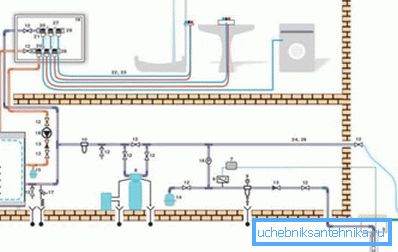
- 14 - hydroaccumulator, designed for a pressure of 10 bar with a volume of 50 liters;
- 15 - hydroaccumulator, but already 25 liters at the same pressure;
- 16 - pressure gauge with tap;
- 17 - boiler safety system;
- 18 - internal pump;
- 19 - distribution cabinet;
- 20 - collector;
- 21 - connection;
- 22 - a pipe, in the given scheme 16 on 2;
- 23 - corrugated protective cover;
- 24 - copper pipe with a diameter of 22 mm;
- 25 - also a copper pipe, but diameter - 18 mm;
- 26 - heat insulation;
- 27 - brackets;
- 28 - cap for the collector.
Delving into particular
When organizing water supply, it is necessary to perform all the work on the well, which will determine the success of everything in the future..
The layout of devices under the ground will be simple:
- A - well, casing;
- B - the pump;
- C - check valve;
- D - cable for insurance;
- E - head;

- F - electrical cable to the control system;
- G - low pressure pipeline;
- H is the connecting angle of low pressure;
- I - pipeline;
- J - nut - American;
- K - went to the pipeline from metal-plastic to consumers.
The presence of the caisson chamber is not required when equipping a well, but the chamber is very desirable if water comes from the bottom under pressure.
We advise you to perform a caisson chamber with ventilation and unloading emergency drainage of water outside the house power system:
- A - backfilling of soil, moreover, we advise you to make a powerful clay castle to protect thawed and rainwater from falling down, as well as waters brought up after pumping the well;
- B - bandage cables;
- C - concrete pad;

- D - the pump;
- E - waterproofing;
- F - sand-concrete sprinkling of the chamber, the recommended ratio of sand and cement is 5 to 1.
findings
The question of how to make water in the country from a well has more than one solution, but often only one of them will meet your specific operating conditions.
It will be necessary to take into account many nuances, some of which will need to be borne in mind at the design stage of the house as a whole.
- Therefore, firstly, the instruction requires the inclusion of a detailed plan for providing water to the house at the design stage of the suburban area.
- And, secondly, it will be very difficult to cope with an experienced integrated team of builders to do all the work on a turnkey basis.
However, this will convince you and an additional video in this article, which we recommend to watch more than once.